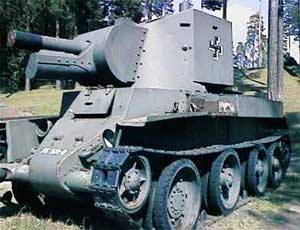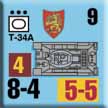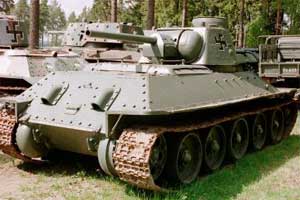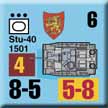Arctic Front:
Finnish Tanks
By Mike Bennighof, Ph.D.
March 2022
 Panzer Grenadier: Arctic
Front is a special Gold Club downloadable expansion set that introduces Finnish forces to the Panzer
Grenadier game series, including this small nation’s
very small armored force. We’ll take a look here at
the pieces and the vehicles they represent. Panzer Grenadier: Arctic
Front is a special Gold Club downloadable expansion set that introduces Finnish forces to the Panzer
Grenadier game series, including this small nation’s
very small armored force. We’ll take a look here at
the pieces and the vehicles they represent.
When the Winter War broke out in late 1939, Finland had one
tank battalion, at least on paper. This unit consisted of
three companies with 20 ancient Renault FT-17 tanks, and one
with six more modern Vickers-built Six-Ton tanks. The Vickers
tanks came without armament, and 20 more were on hand but
not ready for combat. Another six vehicles from the order arrived
after the war was over. The handful with actual armament took part in the lone
Finnish tank attack of the war.
 
Large numbers of Soviet tanks fell into Finnish hands during
the Winter War, and these re-equipped the armored battalion.
About 35 T-26 tanks, the Soviet version of the Vickers Six-Ton,
now served in the tank companies alongside the surviving Vickers,
giving the unit relatively standard equipment. The Vickers
vehicles received Soviet-made 45mm guns taken from destroyed
tanks, and the Finns now called all of the tanks T-26 regardless
of origin. Two T-28 medium tanks were also refurbished and
issued to the troops.
More T-26 tanks entered the Finnish inventory during the
opening weeks of the Continuation War, begun when Finland
attacked the Soviet Union alongside Germany in June 1941.
About 430 Soviet tanks fell into Finnish hands or were destroyed,
and by early 1942 90 T-26 (including both ex-Soviet and British-made
vehicles) were in service, and the armored battalion was upgraded
to brigade status.

A BT-42, a museum piece then and now.
Parola Armour Museum, Finland.
Finnish commanders wanted more firepower, and in 1943 the
Finnish VTT works began re-building captured BT-7 tanks
as BT-42 assault guns. These had an armored box welded together
from plates taken from destroyed Soviet tanks. Within it was
mounted a British-made 114mm howitzer never intended as tank
armament: During the battles of June 1944, BT-42s hit a single
T-34/85 eighteen times without any discernable effect.

In the summer of 1942, with little action happening at the front, the
armored brigade was combined with one of the elite jäger
brigades to form an armored division. Realizing their T-26
tanks could not match Soviet armor, even when rebuilt as assault
guns, the Finns cast about for better tanks. Though Finnish
soldiers seem to have had a knack for snaring intact enemy
tanks, only two T-34/76 and one KV joined the Finnish
forces by 1942 through capture.

The Finns greatly respected the fighting power of the T-34,
and Germany promised to deliver enough of them to re-equip
the armored brigade. The Germans also promised a large amount
of other ex-Soviet equipment, but reneged. Only three T-34
tanks came from the Germans, who probably never intended to
fulfill these agreements and did not have the vehicles to
give. German units usually held onto their captured T-34s,
using them until they broke down through lack of maintenance,
often with fatal damage.

One of three T-34 tanks delivered by Germany
in 1944. Parola Armour Museum, Finland.
The Finns also purchased the German Sturmgeschutz IIIG assault
gun, taking delivery of 30 in 1943. This became known as the
Stu-40 in Finland, and the crews liked its excellent optics
and powerful anti-tank gun. The Finns wanted more but could
not get them from Alkett, the manufacturer. Another 29 finally
arrived during the battles of June 1944.
 
As part of Finland’s desperate requests for modern
weaponry during the 1944 battles, they also asked for modern
German tanks. The Germans finally delivered 15 PzKw IVJ tanks
late in the summer, but the new battalion only became combat-ready
in September, just in time for Finland to switch sides. In
contrast to the assault guns, the Finns disliked the tank
and named it the “Shaker” for its intense vibrations.
Even at slow speed, Finnish crews claimed it was almost impossible
to aim the 75mm gun, and the tank had to stop dead to fire.
German tank crews had no such complaints, and liked the tank
very much. American tank veterans also report no such weaknesses
in the vehicles they faced, other than the hand-cranked turret
which replaced the electric traverse of previous models. As
this was the newest tank in the German inventory (production
began in June 1944), it seems likely that Nibelungenwerke
used the Finnish shipment as an opportunity to unload 15 vehicles
that failed to meet German Army or SS acceptance standards.
Don’t wait to put Arctic Front on your game table! Join the Gold Club and find out how to add it to your collection!
Sign up for our newsletter right here. Your info will never be sold or transferred; we'll just use it to update you on new games and new offers.
Mike Bennighof is president of Avalanche Press and holds a doctorate in history from Emory University. A Fulbright Scholar and NASA Journalist in Space finalist, he has published a great many books, games and articles on historical subjects; people are saying that some of them are actually good.
He lives in Birmingham, Alabama with his wife, three children, and his Iron Dog, Leopold.
Want to keep Daily Content free of third-party ads? You can send us some love (and cash) through this link right here.
|
